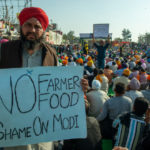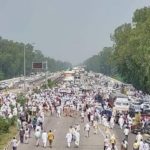Report from the general election in the state of Bihar, India, focusing on the development on the left – Editors.
Indian politics has historically been a confused state of affairs. With a multiparty democracy, Indian elections have always witnessed their fair share of politics and drama around pre- & post-poll alliances and horse-trading of politicians by major bourgeois political formations. The upsurge of support for the far-right in India since 2014, has made matters far worse for the progressive forces in the country, which more often than not would fall victim to these tactics of the major political formations in the subcontinent. Since 2009, the mainstream electoral left in India has seen a drastic political and electoral decline. While the sway which the left had over Indian civil society has somewhat declined, the rate of decline of their influence in electoral politics was not only stark but also worrisome for Indian democracy as a whole. This becomes more significant because historically, the left in India, though mainly Stalinist or Maoist ideologically, has always been a recognised force of social change and social advocacy in the country, be it within the civil society movements or electoral politics.
At the same time, it has to be mentioned also that in spite of their advocacy and social movements in support of the marginalised, these forces have also been one of the many reasons for the failure of any sustained process of the generation of any kind of social revolution in India beyond electoral politics. The electoral essentialism of many of these groups, has been one of the primary reasons of the failures of the Indian mainstream left in addressing issues which are faced by the workers and other marginalised sections on an everyday basis.
In the recently concluded Legislative Assemble Elections in India’s poorest state, Bihar, the right-wing politician, Nitish Kumar has been elected as the Chief Minister (CM) of the state from the National Democratic (?) Alliance (NDA). There was, however, some form of a resurgence of the electoral left in the country in the elections as well. The contest was primarily between two fronts: the NDA and the Mahagathbandhan (the Grand Alliance). Whilst the NDA was led by the Bharatiya Janata Party (BJP) and the Janata Dal United (the People’s Party, JDU), the Mahagathbandhan(MGA) was led by Tejaswi Yadav’s Rashtriya Janata Dal (RJD, the National People’s Party of the India). Yadav is the son of Lalu Prasad Yadav, the former CM of Bihar from 1990 to 1997, whose office was interrupted midway for a brief period by President’s direct rule. The RJD was accompanied by the Indian National Congress (INC) and the three major mainstream Communist Parties in the country- the Communist Party of India (CPI), the Communist Party of India (Marxist) (CPM) and the Communist Party of India (Marxist-Leninist)-Liberation (CPIML). Trotskyist formations like Workers’ Socialist Party (WSP) along with the Communist Party of India (Marxist-Leninist)-Red Star (CPIMLRS) and other mainstream Pro-Maoism political formations opposed the alliance by labelling it as reactionary and reformist. The erstwhile Communist League of India, now renamed as Revolutionary Workers’ Party of India (RWPI), also fielded separate candidates outside the MGA, even though ideologically, it still adheres to the line dictated by orthodox Stalinism.
Unitedly, within the MGA, the left contested 29 seats, out of which it secured victories in 16 seats with a success percentage of 55%- one of the highest among all the parties who contested the polls. The CPIML bagged 12 seats, while the CPM and the CPI won 2 seats each. It is worth mentioning in this regard that, since the declaration of the elections, the left in Bihar had been garnering its forces in the region. The sharing of the seats among the various left-wing parties does not come as a surprise because while the CPIML has been historically a strong force in Bihar, the CPM has been so more in West Bengal or Kerala. The CPI, on the other hand, enjoys a sporadic presence in almost all the spaces dominated by the left nationally. The elections also witnessed the decline of the INC, which managed to win only 19 out of the 70 seats it contested. However, one of the surprises in the elections was Asaduddin Owaisi’s All India Majlis-e-Ittehadul Muslimeen (AIMIM), which went on to win 5 of the 20 seats it contested. The rise of the AIMIM, comes at the expense of the decline of the other parties in the region. It also reflects the manner in which the Muslims in the regions perceive themselves electorally, who have been historically attuned to a politics of compromise, either with the INC or with the electoral left- the failure of which has been attested by the growing popularity of the AIMIM among them.
The Bihar elections have opened up a plethora of discussions within the public discourse, especially those focusing on the West Bengal and Assam elections which are due in the coming year. While the CPIML and CPM have been at virtual loggerheads ever since the day of the elections regarding ‘who the main enemy of the left is in West Bengal- the Trinamool Congress (TMC) or the BJP’, the BJP has been further exploring its avenues in both the states. In Assam, though the Stalinist left, the Trotskyists, the INC and the liberal or centre-left, are in continuous discussions among themselves, they have not been able to come to a conclusive arrangement. It has to be emphasised and taken-into-account that the political character of the TMC and the RJD are entirely different. The RJD is a party, which though populist, has always stood up to the divisive right-wing hyper Hindu-Nationalist politics of the BJP. To go back a bit in history, it was Lalu Yadav who had got L.K. Advani, the then leader of the BJP, arrested during the Rath Yatra (Chariot March) which ultimately resulted in the demolition of the Babri Masjid, a feat untouched by any other CM in living memory. The Asom Gana Parishad (AGP) in Assam, with whom the left in Assam has had a chequered history, and the TMC, which has been inflicting violent attacks on the left-wing activists, in West Bengal, do not have such glaring histories of standing up to the far-right.
The Indian left is now at crossroads. Though it realises that the time is ripe now to forge an organic solidarity between the various left-wing forces in the country, it faces severe setbacks in terms of the lack of co-ordination between the leaders, especially between the two largest parties on the left- the CPM and the CPIML. It is nothing unusual for the left in India to struggle united against a particular government’s policies, which they have been engaging in for decades under joint platforms. However, it has to choose its non-explicitly left-wing allies very carefully depending on a deeper analysis of history and contemporary political trajectories. In doing so, it has to also ensure that the process of forming such alliances does not harm the necessary but very slippery slope of unity which has been constructed by ardent advocates of left-unity in the country. The requirement for progressive politics in India is a more organically united left, which believes in internal democracy rather than sectarian clashes. If it can overcome such hurdles, the left can definitely be a force to reckon with in the country again, failing which however, there is a possibility, a realistic one, that the left will only be ‘left’ with a corpus of splintered small tactical-ideological groups with very little bargaining power in national politics.
It is beyond doubt, that the actual solution to the innumerable social, economic, political and cultural problems tormenting India goes beyond the narrow domain of electoral politics, something which the mainstream left emphasises more in their programs and activities than actual struggles. Examples like Shaheen Bagh have demonstrated that organically developed people’s struggles can be hugely successful in addressing issues which go beyond elections and encompass the broader social reality. However, any attempt to analyse these issues holistically is a broad and rigorous theoretical project on its own, something which goes beyond the scope of this short article.






0 Comments